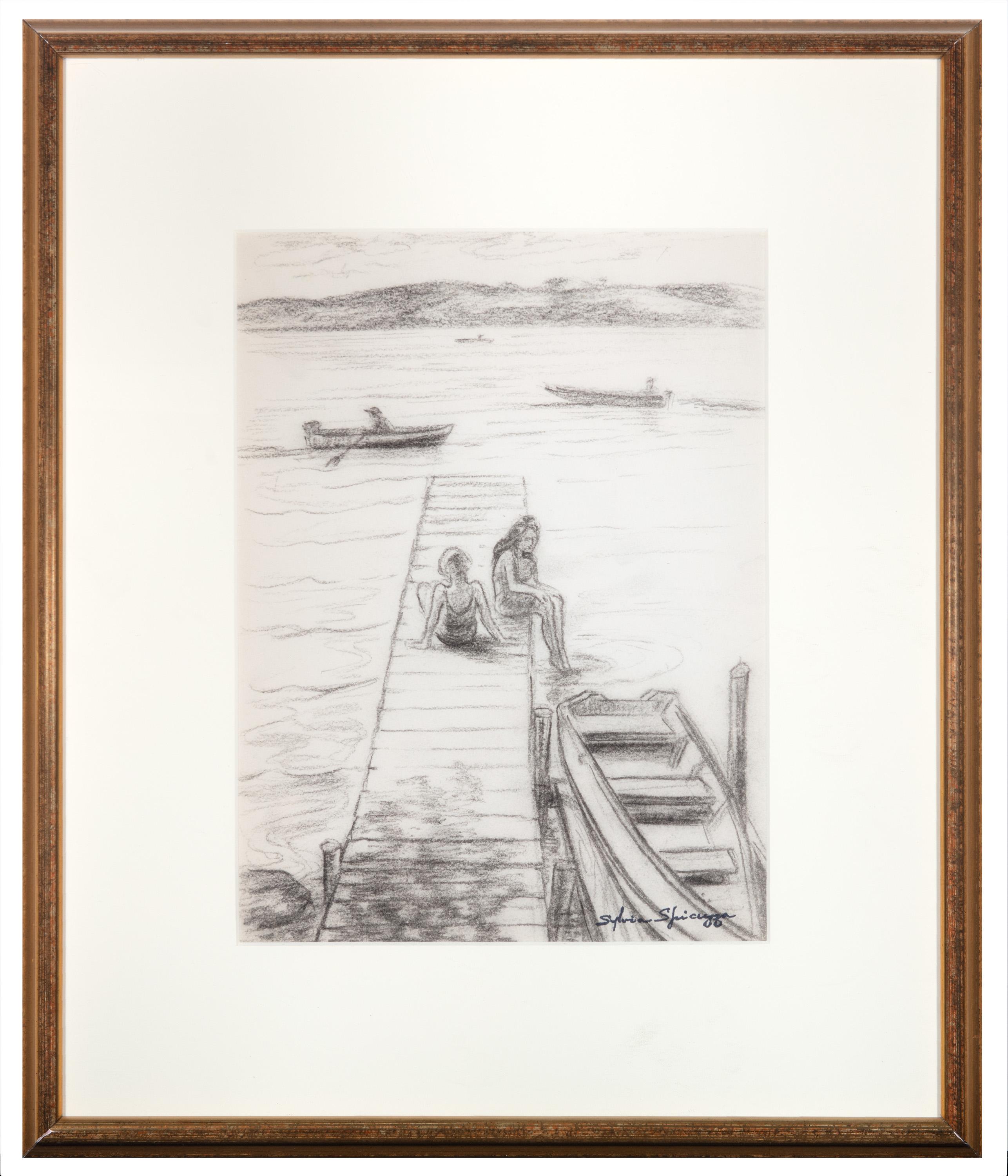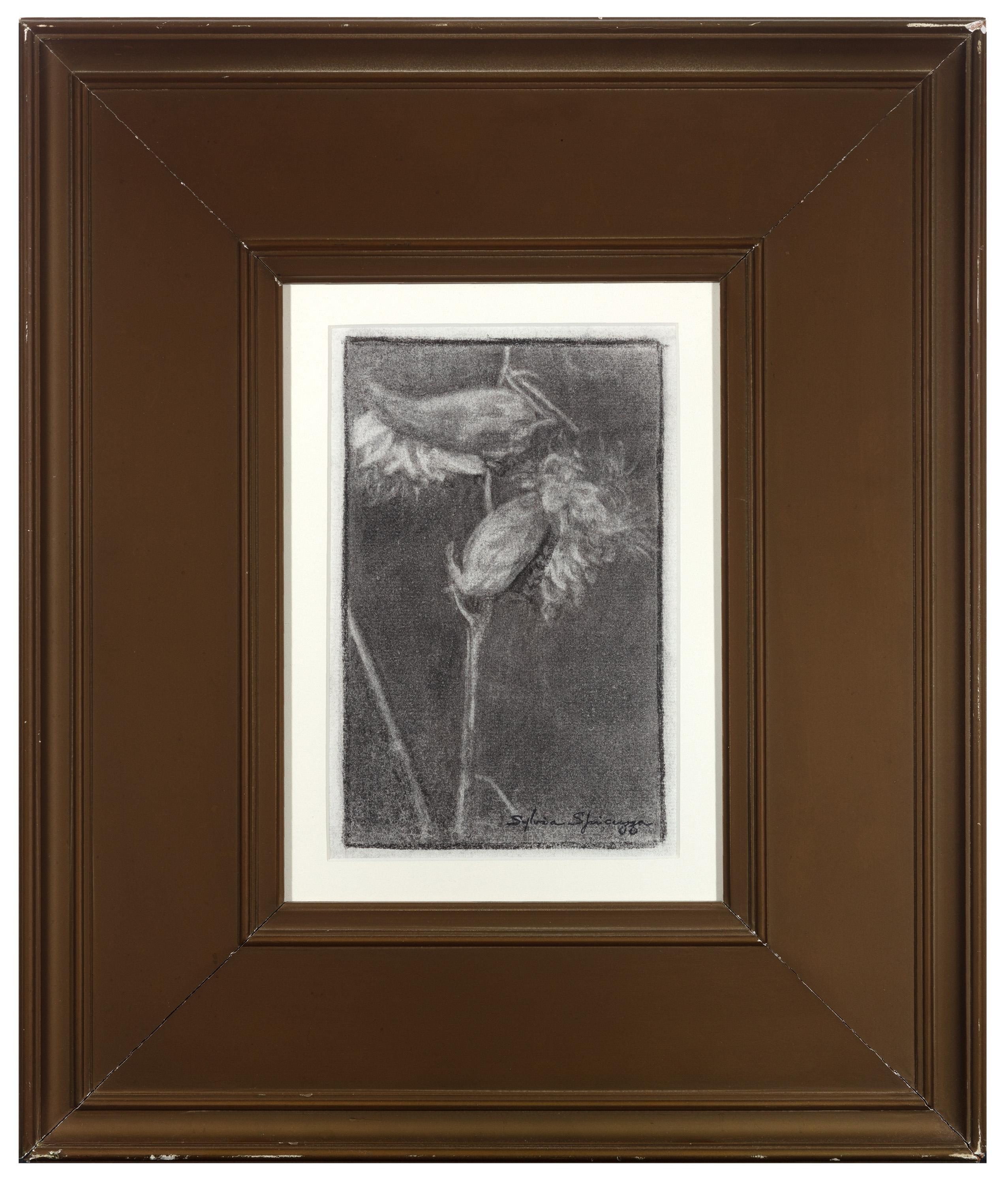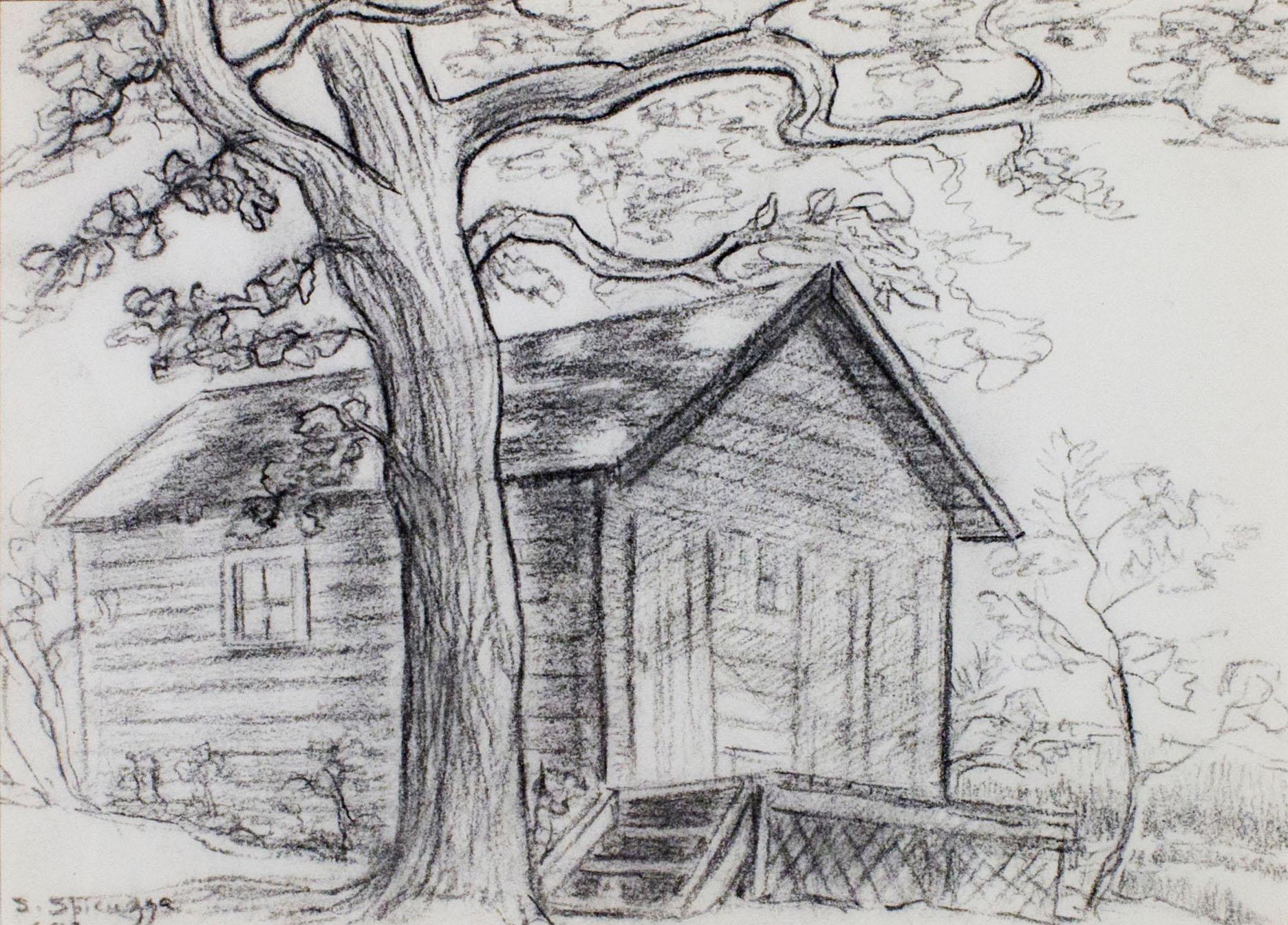Items Similar to "Pigs"
Want more images or videos?
Request additional images or videos from the seller
1 of 7
Daniel Garber"Pigs"1944
1944
About the Item
Jim’s of Lambertville Fine Art Gallery is proud to present this piece by Daniel Garber (1880 - 1958).
One of the two most important and, so far, the most valuable of the New Hope School Painters, Daniel Garber was born on April 11, 1880, in North Manchester, Indiana. At the age of seventeen, he studied at the Art Academy of Cincinnati with Vincent Nowottny. Moving to Philadelphia in 1899, he first attended classes at the "Darby School," near Fort Washington; a summer school run by Academy instructors Anshutz and Breckenridge. Later that year, he enrolled at the Pennsylvania Academy of the Fine Arts. His instructors at the Academy included Thomas Anshutz, William Merritt Chase and Cecilia Beaux. There Garber met fellow artist Mary Franklin while she was posing as a model for the portrait class of Hugh Breckenridge. After a two year courtship, Garber married Mary Franklin on June 21, 1901.
In May 1905, Garber was awarded the William Emlen Cresson Scholarship from the Pennsylvania Academy, which enabled him to spend two years for independent studies in England, Italy and France. He painted frequently while in Europe, creating a powerful body of colorful impressionist landscapes depicting various rural villages and farms scenes; exhibiting several of these works in the Paris Salon.
Upon his return, Garber began to teach Life and Antique Drawing classes at the Philadelphia School of Design for Women in 1907. In the summer of that same year, Garber and family settled in Lumbertville, Pennsylvania, a small town just north of New Hope. Their new home would come to be known as the "Cuttalossa," named after the creek which occupied part of the land. The family would divide the year, living six months in Philadelphia at the Green Street townhouse while he taught, and the rest of the time in Lambertville. Soon Garber’s career would take off as he began to receive a multitude of prestigious awards for his masterful Pennsylvania landscapes. During the fall of 1909, he was offered a position to teach at the Pennsylvania Academy as an assistant to Thomas Anshutz. Garber became an important instructor at the Academy, where he taught for forty-one years.
Daniel Garber painted masterful landscapes depicting the Pennsylvania and New Jersey countryside surrounding New Hope. Unlike his contemporary, Edward Redfield, Garber painted with a delicate technique using a thin application of paint. His paintings are filled with color and light projecting a feeling of endless depth. Although Like Redfield, Garber painted large exhibition size canvases with the intent of winning medals, and was extremely successful doing so, he was also very adept at painting small gem like paintings. He was also a fine draftsman creating a relatively large body of works on paper, mostly in charcoal, and a rare few works in pastel. Another of Garber’s many talents was etching. He created a series of approximately fifty different scenes, most of which are run in editions of fifty or less etchings per plate.
Throughout his distinguished career, Daniel Garber was awarded some of the highest honors bestowed upon an American artist. Some of his accolades include the First Hallgarten Prize from the National Academy in 1909, the Bronze Medal at the International Exposition in Buenos Aires in 1910, the Walter Lippincott Prize from the Pennsylvania Academy and the Potter Gold Medal at the Art Institute of Chicago in 1911, the Second Clark Prize and the Silver Medal from the Corcoran Gallery of Art for “Wilderness” in 1912, the Gold Medal from the Panama-Pacific Exposition in San Francisco of 1915, the Second Altman Prize in1915, the Shaw prize in 1916, the First Altman Prize in 1917, the Edward Stotesbury Prize in1918, the Temple Gold Medal, in 1919, the First William A. Clark Prize in 1921, the Gold Medal from the Philadelphia Art Club in 1923, the Carnegie Institute Bronze Medal in 1924, the Gold Medal of Honor in 1929, the Jenny Sesnan Gold Medal in 1937, the Pennell Medal in 1942, and the Pennsylvania Academy Fellowship Award in1947 among many others.
Daniel Garber and Edward Redfield are known by most art enthusiasts as the two leading figures associated with the New Hope Art Colony. This is a correct assessment, but in the broader scope, as key figures in twentieth century American Art, their importance is equally paramount. As this group, once considered regional, secures it’s place in history, painters like Garber and Redfield are destined to be considered the true American Masters by the international art world.
Garber's work is included in nearly thirty museum collections nationally and this number is growing. He is also the first of the "New Hope School" painters to exceed the million dollar mark at auction which occurred in 2003.
- Creator:Daniel Garber (1880-1958, American)
- Creation Year:1944
- Dimensions:Height: 18.25 in (46.36 cm)Width: 24.25 in (61.6 cm)Depth: 1 in (2.54 cm)
- Medium:
- Movement & Style:
- Period:
- Condition:
- Gallery Location:Lambertville, NJ
- Reference Number:
About the Seller
5.0
Vetted Seller
These experienced sellers undergo a comprehensive evaluation by our team of in-house experts.
Established in 1997
1stDibs seller since 2014
36 sales on 1stDibs
Typical response time: 6 hours
- ShippingRetrieving quote...Ships From: Lambertville, NJ
- Return PolicyThis item cannot be returned.
More From This SellerView All
- "View of Lambertville"By Daniel GarberLocated in Lambertville, NJJim’s of Lambertville Fine Art Gallery is proud to present this piece by Daniel Garber (1880 - 1958). One of the two most important and, so far, the most valuable of the New Hope Sc...Category
1940s American Impressionist Landscape Drawings and Watercolors
MaterialsPaper, Charcoal
- "Bare Tree"By Daniel GarberLocated in Lambertville, NJJim’s of Lambertville Fine Art Gallery is proud to present this piece by Daniel Garber (1880 - 1958). One of the two most important and, so far, the most valuable of the New Hope School Painters, Daniel Garber was born on April 11, 1880, in North Manchester, Indiana. At the age of seventeen, he studied at the Art Academy of Cincinnati with Vincent Nowottny. Moving to Philadelphia in 1899, he first attended classes at the "Darby School," near Fort Washington; a summer school run by Academy instructors Anshutz and Breckenridge. Later that year, he enrolled at the Pennsylvania Academy of the Fine Arts. His instructors at the Academy included Thomas Anshutz, William Merritt Chase and Cecilia Beaux. There Garber met fellow artist Mary Franklin while she was posing as a model for the portrait class of Hugh Breckenridge. After a two year courtship, Garber married Mary Franklin on June 21, 1901. In May 1905, Garber was awarded the William Emlen Cresson Scholarship from the Pennsylvania Academy, which enabled him to spend two years for independent studies in England, Italy and France. He painted frequently while in Europe, creating a powerful body of colorful impressionist landscapes depicting various rural villages and farms scenes; exhibiting several of these works in the Paris Salon. Upon his return, Garber began to teach Life and Antique Drawing classes at the Philadelphia School of Design for Women in 1907. In the summer of that same year, Garber and family settled in Lumbertville, Pennsylvania, a small town just north of New Hope. Their new home would come to be known as the "Cuttalossa," named after the creek which occupied part of the land. The family would divide the year, living six months in Philadelphia at the Green Street townhouse while he taught, and the rest of the time in Lambertville. Soon Garber’s career would take off as he began to receive a multitude of prestigious awards for his masterful Pennsylvania landscapes. During the fall of 1909, he was offered a position to teach at the Pennsylvania Academy as an assistant to Thomas Anshutz. Garber became an important instructor at the Academy, where he taught for forty-one years. Daniel Garber painted masterful landscapes depicting the Pennsylvania and New Jersey countryside surrounding New Hope. Unlike his contemporary, Edward Redfield, Garber painted with a delicate technique using a thin application of paint. His paintings are filled with color and light projecting a feeling of endless depth. Although Like Redfield, Garber painted large exhibition size canvases with the intent of winning medals, and was extremely successful doing so, he was also very adept at painting small gem like paintings. He was also a fine draftsman creating a relatively large body of works on paper, mostly in charcoal, and a rare few works in pastel. Another of Garber’s many talents was etching. He created a series of approximately fifty different scenes, most of which are run in editions of fifty or less etchings per plate. Throughout his distinguished career, Daniel Garber was awarded some of the highest honors bestowed upon an American artist. Some of his accolades include the First Hallgarten Prize from the National Academy in 1909, the Bronze Medal at the International Exposition in Buenos Aires in 1910, the Walter Lippincott Prize from the Pennsylvania Academy and the Potter Gold Medal at the Art Institute of Chicago in 1911, the Second Clark Prize and the Silver Medal from the Corcoran Gallery of Art for “Wilderness” in 1912, the Gold Medal from the Panama-Pacific Exposition in San Francisco of 1915, the Second Altman Prize in1915, the Shaw prize in 1916, the First Altman Prize in 1917, the Edward Stotesbury Prize in1918, the Temple Gold Medal, in 1919, the First William A...Category
Early 20th Century American Impressionist Landscape Drawings and Waterco...
MaterialsPaper, Charcoal
- "Horse Cart"By Daniel GarberLocated in Lambertville, NJJim’s of Lambertville Fine Art Gallery is proud to present this piece by Daniel Garber (1880 - 1958). One of the two most important and, so far, the most valuable of the New Hope Sc...Category
Early 20th Century American Impressionist Landscape Drawings and Waterco...
MaterialsPaper, Graphite
- "Central Park"By William Langson LathropLocated in Lambertville, NJJim’s of Lambertville is proud to offer this artwork. Signed. Complemented by a hand carved and gilt frame. William L. Lathrop (1859-1938) Deemed “Father of the New Hope Art Colony”, William Langson Lathrop was born in Warren, Illinois. He was largely self-taught, having only studied briefly with William Merritt Chase in 1887, at the Art Students League. Lathrop first moved east in the early 1880s, and took a job at the Photoengraving Company in New York City. While there, he befriended a fellow employee, Henry B. Snell. The two men became lifelong friends and ultimately, both would be considered central figures among the New Hope Art Colony. Lathrop's early years as an artist were ones of continuing struggle. His efforts to break through in the New York art scene seemed futile, so he scraped enough money together to travel to Europe with Henry Snell in1888. There he met and married an English girl, Annie Burt. Upon returning to New York, he tried his hand at etching, making tools from old saw blades. Even though his prints were extremely beautiful, he still was impoverished. Lathrop would return to his family in Ohio, before once again attempting the New York art scene. In 1899, with great trepidation, he submitted five small watercolors to an exhibit at the New York Watercolor Club. He won the Evans Prize, the only award given, and four of the five paintings were sold the opening night. At age forty Lathrop’s career would finally take off and he became an “overnight success Lathrop came to Phillips Mill for the first time in1898, to visit his boyhood friend, Dr. George Marshall. Shortly after, he and his family purchased the old miller’s house from Dr. Marshall. The Lathrop’s home became a social and artistic center for the growing New Hope colony. Tea and fascinating conversation was the “order of the day” every Sunday. This was a scene fondly recalled by many younger art students that Lathrop taught privately at Phillips Mill. It was common to see groups of his students painting and sketching along the banks of the canal or aboard his canal boat. He had previously taught in the Poconos and at the Lyme, Connecticut Summer School in1907, but Phillips Mill always remained Lathrop’s permanent address. In 1928, a committee headed by Lathrop was formed to purchase the old Phillips Mill building as a place to hold community gatherings and art exhibitions. The committee had success and in 1929 the Phillips Mill Community Association was formed. This became the center of the New Hope Art Colony holding annual exhibitions and still operating today. In 1930, Lathrop had built a sailboat he named the “Widge”. For eight consecutive seasons he sailed it along the coast of Long Island...Category
Early 20th Century American Impressionist Landscape Drawings and Waterco...
MaterialsPaper, Graphite
- "St. Ives in the Evening"By Hayley LeverLocated in Lambertville, NJJim’s of Lambertville is proud to offer this artwork. Signed and dated lower right. Hayley Lever (1876-1958) Hayley Lever's exceptional career path took him from the shores of ...Category
1910s American Impressionist Landscape Drawings and Watercolors
MaterialsWatercolor
- "Lunch at the Stockton Inn"By Daniel GarberLocated in Lambertville, NJJim’s of Lambertville is proud to offer this artwork. Signed lower left. Pencil drawing. Complemented by a hand carved and gilt frame. Daniel Garber (1880-1958) ...Category
20th Century American Impressionist Landscape Drawings and Watercolors
MaterialsPaper, Pencil
You May Also Like
- "Summertime Fun at Big Cedar Lake" original charcoal drawingBy Sylvia SpicuzzaLocated in Milwaukee, WIIn this drawing, Sylvia Spicuzza presents the viewer with a scene of two young women relaxing on a dock in a lake. A dinghy floats beside them as other boats traverse the water. This drawing is reminiscent of the work done by her father Francesco, who is better known for landscapes in the Impressionist style. 12 x 9 inches, artwork 18.63 x 15.75 inches, frame Stamped with artist's signature, lower right Born in 1908, Sylvia Spicuzza was the daughter of noted painter Francesco Spicuzza. Sylvia devoted herself to teaching art to the students of Lake Bluff...Category
1950s American Impressionist Figurative Drawings and Watercolors
MaterialsCharcoal
- "Milkweed Pod I #528" Original Charcoal DrawingBy Sylvia SpicuzzaLocated in Milwaukee, WIIn this drawing, Sylvia Spicuzza presents the viewer with a dark, subtle view of two milkweed pods, bursting forth with cotton. Examples like this show the ability of Spicuzza to draw in a naturalistic style, where most of her work is usually in a highly stylized, graphic mode. The richness and depth of the black charcoal makes for a moody image. 8 x 5 inches, artwork 18 x 14.5 inches, frame Born in 1908, Sylvia Spicuzza was the daughter of noted painter Francesco Spicuzza. Sylvia devoted herself to teaching art to the students of Lake Bluff...Category
1920s American Impressionist Figurative Drawings and Watercolors
MaterialsPaper, Charcoal
- "Still Life with Fruit" original charcoal drawing by Sylvia SpicuzzaBy Sylvia SpicuzzaLocated in Milwaukee, WIIn this drawing, Sylvia Spicuzza presents the viewer with a dark, subtle view of two apples, still clinging to their leaves. Examples like this show the ability of Spicuzza to draw i...Category
1920s American Impressionist Figurative Drawings and Watercolors
MaterialsPaper, Charcoal
- "Old Cabin Near Big Cedar Lake" original charcoal drawing by Sylvia SpicuzzaBy Sylvia SpicuzzaLocated in Milwaukee, WIIn this drawing, Sylvia Spicuzza presents the viewer with a lakeside cabin under the shade of a massive tree. This drawing is reminiscent of the work done by her father Francesco, wh...Category
1950s American Impressionist Landscape Drawings and Watercolors
MaterialsCharcoal
- Ships at the Harbor - Nautical Seascape with Seagulls in Charcoal on PaperLocated in Soquel, CAShips at the Harbor - Nautical Seascape in Charcoal on Paper Detailed and layered harbor scene by Maude Folmar Ramsey (American, 1908-1993). The viewer is looking out at the harbor, across the water from the docks, buildings, and ships. The pillars, buildings, and masts are jumbled together in a pleasing manner that is almost abstract. Despite the simplified shapes, this piece is full of detail. This piece is executed in a rectilinear style frequently seen in American mid-century modern compositions. Signed in the lower right corner "Maude Folmar" Presented in a wood frame with a double mat. Frame size: 25.25"H x 29.25"W Image size: 17"H x 21.5"W Maude Love (Folmar) Ramsey (American, 1908-1993) studied at the School of Fine Arts at Washington University in St. Louis, Missouri. She was the director of the Laguna Gloria Art Museum from 1968-1972. Ramsey was one of the charter members of the “Waterloo...Category
Mid-20th Century American Impressionist Landscape Drawings and Watercolors
MaterialsPaper, Charcoal
- Sledders - Winter Snow Scene - Kids playing on Sleds, Charcoal drawing c 1950-60By Alice Kent StoddardLocated in Rancho Santa Fe, CAAlice Kent Stoddard 1885-1976 Sledders (circa 1950-1960) Black chalk on card Image Dimensions: 19.75 x 16 inches (50.2 x 40.6 cm) Framed Dimensions: 26.5 x 22.3 inches Signed lower...Category
Mid-20th Century American Impressionist Figurative Drawings and Watercolors
MaterialsCharcoal, Cardboard
Recently Viewed
View AllMore Ways To Browse
New Hope School
Antique French Drawings
April 11
Antique Drawings America
Antique American Drawings
Small Antique Drawing
Chasing The Light
Light On The Pacific
Pig Art
American Potter
Small Drawing Gold Frame
Drawing Vintage Hare
American Antique Figures
Vintage Feed
Paris Street Scene Drawing
Drawing Vintage Key
North American Auction
Hare Plate





